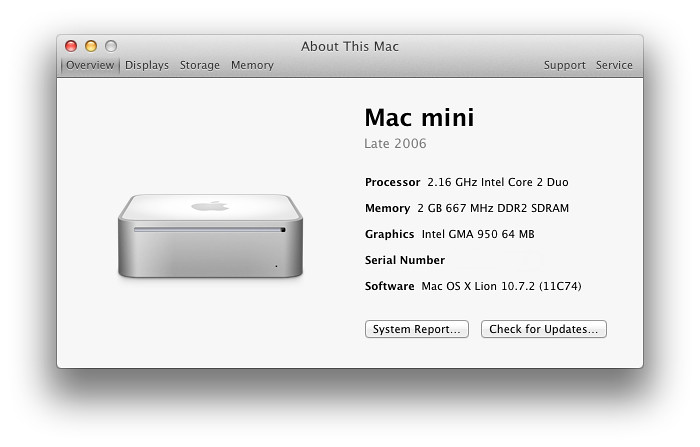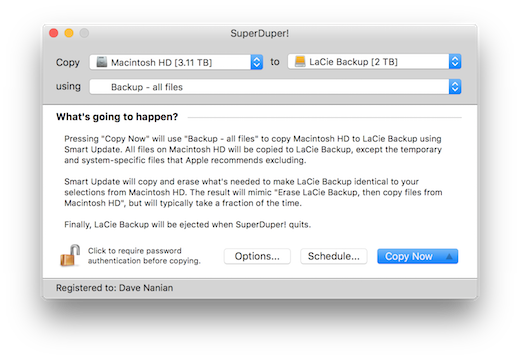The new Apple File System (APFS) that replaces the long-running HFS+ in macOS caused a lot of concern and confusion, because it seemed like a massive change, but the effects aren’t noticeable to end users, except in improving the speed of SSD-only Macs. (Apple doesn’t upgrade hard drives to APFS, and hasn’t yet released a Fusion APFS update for its mixed SSD/hard drive systems.)
Generally speaking, there isn’t a ton of advantage to using APFS drives externally. They have some nice features, but they are also poorly documented which means that tools like carbon copy clones. And a whole lot more. SuperDuper is the most advanced, yet easy to use disk copying program available for macOS. It can, of course, make a full backup, or 'clone' — in moments, you can completely duplicate your boot drive to another drive, partition, or image file. Carbon Copy Cloner Alternatives. Carbon Copy Cloner is described as '(CCC) features an interface designed to make the cloning and backup procedure very intuitive' and is a popular app in the Backup & Sync category. There are more than 25 alternatives to Carbon Copy Cloner for a variety of platforms, including Windows, Mac, Linux, Android.
Carbon Copy Cloner Reviews
APFS restructures how files are stored in a disk partition, but it doesn’t change how programs access files within the operating system. When copying individual files or cloning a drive with Disk Utility, SuperDuper, or Carbon Copy Cloner ($40), macOS continues to abstract interaction with files, so you don’t have to learn anything about the filesystem to use it or to use cloning software. (That’s just so long as the cloning software is up to date. Carbon Copy Cloner released a major update for APFS weeks ago, and SuperDuper finished its beta testing and released an APFS-ready version 3.0 on November 8.)
Macworld reader Doyle wonders if any of this causes issues when migrating from one drive to another. He wants to upgrade from his existing SSD to one that’s larger, and he’s previously relied on Disk Utility. Because Apple has provided much detail about APFS, he’s concerned that this might not work this time out. He’d prefer to use Disk Utility, but isn’t opposed to buying a piece of software to clone if it would provide extra abilities.


The good news is you can use Disk Utility just as you have in previous releases to migrate a drive. You need to format the new drive with APFS before initiating the clone, and you can boot into Recovery as in the past to perform the clone.
Carbon Copy Cloner Restore Apfs
However, there’s one thing that Disk Utility cannot manage: installing a new Recovery Disk on a freshly formatted macOS drive. For that, you need Carbon Copy Cloner or SuperDuper, both of which can clone an existing Recovery Disk onto another drive. Apple only supports creating this very critical piece of macOS troubleshooting, also required for using FileVault, when you perform a full macOS installation. (SuperDuper can’t use HFS+ as a destination for cloning a Recovery Disk, however. Read this blog post for more particulars.)
If you want to use an all-Disk Utility method in High Sierra, you need to follow these steps:
- Run macOS Installer for High Sierra and complete a full installation on the new drive.
- When finished, restart and choose Recovery (Command-R at startup).
- Launch Disk Utility from the Recovery startup list.
- Control-click the new main partition on your new drive and choose Restore.
- Select your old drive’s main partition in the Restore From menu and click Restore.
With Carbon Copy Cloner or SuperDuper, you can follow either program’s instructions to clone the Recovery partition, and skip step 1 above. This eliminates installing macOS, which can take some time. Then, you can follow steps 2 to 5 and complete the clone.
If you need to swap a drive out of your Mac instead of having both connected at once, I’d recommend using either SuperDuper or Carbon Copy Cloner to help with that after either installing macOS on the external drive or using Carbon Copy Cloner or SuperDuper to clone Recovery. Then:

- Make a clone of your current drive either as a complete partition or as a disk image on an external drive using either app (or update an existing clone).
- Shut your Mac down and swap the internal drive for the new one.
- Boot into Recovery.
- Launch Disk Utility from the Recovery startup list.
- Control-click the new main partition on your new drive and choose Restore.
- Select the clone if it’s a partition or click Image to select a disk image backup and click Restore.
Correction: This article originally didn’t mention SuperDuper’s ability to clone a Recovery Disk, which was added in the latest version, and works only for an APFS destination.
Ask Mac 911
Make Apfs Bootable
We’ve compiled a list of the questions we get asked most frequently along with answers and links to columns: read our super FAQ to see if your question is covered. If not, we’re always looking for new problems to solve! Email yours to mac911@macworld.com including screen captures as appropriate, and whether you want your full name used. Every question won’t be answered, we don’t reply to email, and we cannot provide direct troubleshooting advice.
